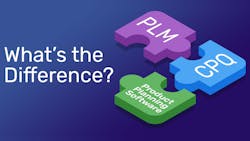What’s the Difference Between PLM, CPQ and Product Planning Software?
Companies of all kinds benefit from early, expert planning. Before spending time and money, companies need to plan and control product configurations and constraints, which are key to design, engineering and product specifications. All of this requires that management look at legal, engineering, operations and financial concerns, as well as customers’ needs.
Software for product lifecycle management (PLM) and to configure price quotes (CPQ) simplify the tasks of product planners to align and then define the steps needed to take a product through manufacturing. CPQ is valuable in later project development stages to make sales efficient. PLM, on the other hand, is best used in the design and development stages by engineers and designers.
Both PLM and CPQ assume the product exists and decisions about what to make have been made. However, prior to this, product planning focuses on customers’ needs and preferences and what products and features should be offered to satisfy those needs and preferences. But most product planning relies on disjointed tools such as email, PowerPoint and spreadsheets.
Software options like the above—and even some less-specialized programs—are too rigid for manufacturing. Rigidity aside, humans are prone to errors, and these programs do more to facilitate them than prevent them. Product people often find their ability to make quick decisions and changes are at the mercy of the collaboration tools they rely on. This is a bottleneck at worst, and a pair of handcuffs at best.
If and when there are changes to more complex products, these differences should be highlighted, alerting product teams and their managers to potential issues. The most common tools used for these jobs, however, are slow and cause inconsistencies that were, ironically, put in place to prevent them. Often this creates quality control issues and collaboration shortcomings, and just generally slows the process.
CPQ software provides flexibility compared to more conventional project planning software. Most let manufacturers configure products and services, ensure pricing is correct and deliver personalized customer quotes quicker than manual methods.
The accuracy of CPQ software should let it deliver significant return on investment for all types of manufacturers. Quick quotes, customization options—like designs built to spec—and collaboration tools increases efficiency and foster better cooperation between teams.
Evaluating CPQ programs involves recommendations from those using it. Manufacturers must take their own requirements into consideration when looking for the best and most efficient way to generate quotes and process orders. No two manufacturers are the same, after all. Manufacturers must also take customers’ needs into consideration. Then, and only then, can they take CPQ pricing elements, visualization capabilities, and integration of order entry and sales into account. Once they get there though, they’ll find themselves with a better production schedule.
PLM ties product configuration to the engineering definitions of manufacturing components. In doing so, it lets the company manage designs and iterations, as well as bills of materials for engineering and production.
But there’s a downside. Using PLMs often allows little room for collaboration on features and products due to its built-in rigidity. In short, it’s a limited tool, but when used, its shortcomings are minimal. Most of its limitations involve roadmap software not providing a clear understanding of automated product configurations and constraints. Focusing on a product’s engineering definition leaves little room in early-stage planning for product managers to iterate or change the prototype’s features to reflect changes in the market or customers.
Limitations aside, stakeholders can clear the way for an improving PLM by adding additional steps to the manufacturing process or by using another tool designed around collaborating and clarifying all a product’s nuances.
The best product planning software creates a place to define and establish direction. It addresses issues of access and organizational planning in all development stages.
The software is designed for defining and sharing products and configurations—clearly and concisely. The best of them provide let the product teams easily create and collaborate, while adding efficiency rather than detracting from it, like some tools that can’t scale with growing companies or more complex products.
Maziar Adl is CTO of Gocious, a software development company.
